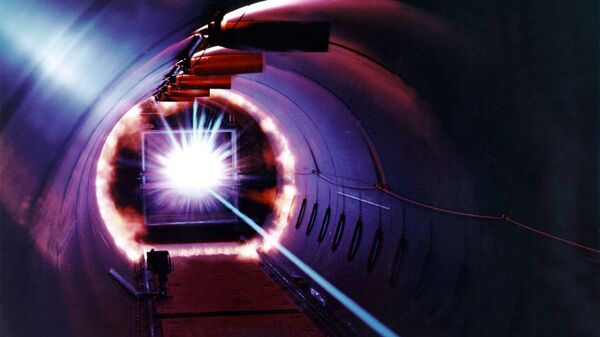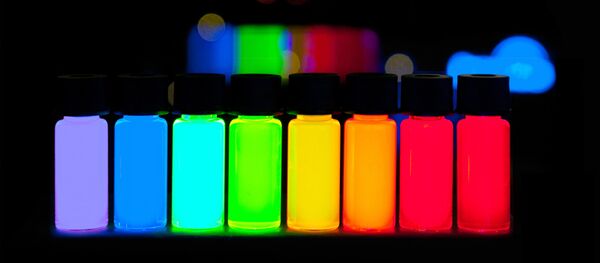Brought to you by the National Research Nuclear University MEPhI
Scientists use them to create energy streams as powerful as nuclear explosions, as well as to generate super-low ambient temperatures. The invention of laser systems was so important that the researchers involved received Nobel Prizes. December 14 marks the 95th birth anniversary of Soviet physicist Nikolai Basov (1922-2001) who developed the theory of laser systems.
Light quanta/photons denoting the smallest portions of an electromagnetic wave’s energy are either absorbed or emitted when electrons shift to higher or lower levels. Forced quanta/photon emissions, induced externally, will create identical photon-oscillation. This phenomenon creates narrow wavelength bands that are typical of laser light. Electrons need to be transferred to lower levels, so that the atom can emit photons. But first they need to be “herded” to higher levels using an external factor. Physicists call this process “pumping.” An atom whose electrons occupy higher levels has been “excited.”
READ MORE: Specialist: Project 5-100 Must be Continued and Expanded to 30 Universities
Excited atoms will emit light all the time subject to adequate feedback. Once activated, this forced light emission will continue to elevate electrons to higher levels, after the photons have been emitted. For this purpose, a light-emitting medium, such as a crystal, is placed inside an optical resonator with two mirrors. The resonator generates multiple light waves and boosts the power of light emissions; in other words, the number of photons increases.
From masers to lasers
In 1916, Albert Einstein became the first scientist to introduce the concept of induced photon emission and absorption. Twenty years later, Soviet physicist Valentin Fabrikant noted the possibility of using induced emissions for amplifying electromagnetic radiation as it passes through various substances.
READ MORE: New Nuclear Reactor Quality Assurance Method Tested in Russia
In May 1952, Nikolai Basov and his academic supervisor Mikhail Prokhorov delivered a report at the national conference on radio-spectroscopy. They said it was possible to use induced light emission for amplifying and generating millimeter-band waves. American physicist Charles Townes made nearly the same conjecture at Columbia University at about the same time.
“In July 1954, the journal Physics Review Letters published an article by Charles Townes, James P. Gordon and H. J. Zeiger that was received by its editorial office on May 5 of the same year. The article’s authors noted that an experimental unit had been developed, and that it could be used as a high-resolution microwave spectrometer, microwave amplifier or as a highly stable generator. This was the first report on the invention of the molecular generator/maser, an acronym for ‘microwave amplification by stimulated emission of radiation,’” says Yevgeny Protsenko, a professor with the Department of Laser Physics at National Research Nuclear University MEPhI (Moscow Engineering Physics Institute).
“Both groups simultaneously suggested and developed an ammonia maser, as proved by their respective Nobel Prizes. It may be surprising, but given the huge difference in initial working conditions, such as a peaceful life in the United States and wartime and postwar hardships in the USSR, both research teams simultaneously reached the finish line and made the highly important discovery for which they were duly awarded,” Joseph Zubarev, a professor with the Department of Laser Physics at National Research Nuclear University MEPhI and a former associate of Nikolai Basov, recalls.
READ MORE: Physicists Unravel Mystery of Stable Fullerenes
Laser (light amplification by stimulated emission of radiation) was developed just six years later. During this time materials and technologies were found that would attain laser-wave parameters ranging between 0.1 and 1,000 micrometers.
“On May 16, 1960, physicist Theodore H. Maiman working at Hughes Research Laboratories created a favorable environment for the stimulated emission of radiation. He used a pulse gas-discharge lamp that enclosed a 1.5-centimeter long ruby crystal with a diameter of about one centimeter. The ruby crystal’s light emission band was narrowed somewhat, highlighting induced light emission. The laser was born on that day,” says Andrei Kuznetsov, Acting Director of MEPhI’s Institute for Laser and Plasma Technologies. In 1978, Nikolai Basov, a graduate of MEPhI, formerly called the Moscow Mechanical Institute, established and headed its department of quantum electronics. Several departments within MEPhI’s Institute for Laser and Plasma Technologies have continued Basov’s work since 2016.
Recently, a group of the Institute’s theoreticians predicted that super-powerful laser pulses could generate magnetic fields in plasma formations, and that such fields would have the strength of tens of millions gauss and more, that is, ten times more than can be attained using other methods. In September 2017, an international team of researchers working at GSI Helmholtz Centre for Heavy Ion Research in Germany (that also employed MEPhI students) confirmed this prediction.





